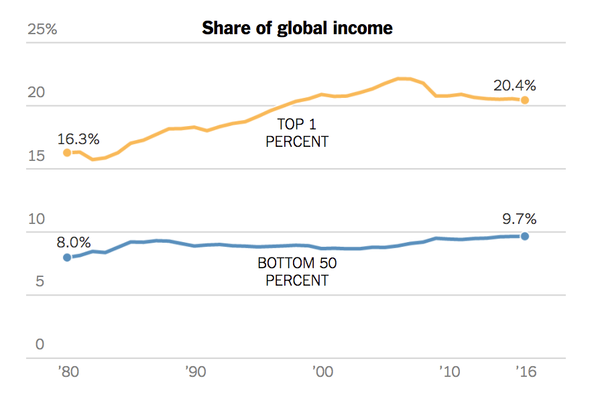WHAT IS BITCOIN?
The 2008 financial crisis caused a lot of people to lose trust in banks as trusted third parties. Many questioned whether banks were the best guardians of the global financial system. Bad investment decisions by major banks had proved catastrophic, with rippling consequences.
Bitcoin — also proposed in 2008 — presented something of an alternative.
According to its whitepaper, Bitcoin was a “peer-to-peer electronic cash system.” It would allow for online payments [to move] from one party to another without going through a financial institution.”
In other words, Bitcoin made digital transactions possible without a “trusted intermediary.” The technology allowed this to happen at scale, globally, with cryptography doing what institutions like commercial banks, financial regulators, and central banks used to do: verify the legitimacy of transactions and safeguard the integrity of the underlying asset.
Bitcoin is a decentralized, public ledger. There is no trusted third party controlling the ledger. Anyone with bitcoin can participate in the network, send and receive bitcoin, and even hold a copy of this ledger if they want to. In that sense, the ledger is “trustless” and transparent.
The Bitcoin ledger tracks a single asset: bitcoin (Note: “Bitcoin” capitalized refers to the Bitcoin ledger, or protocol, while “bitcoin” in lowercase refers to the currency or a unit of account on the Bitcoin ledger).
The ledger has rules encoded into it, one of which states that there will only ever be 21M bitcoin produced. Because of this cap on the number of bitcoins in circulation, which will eventually be reached, bitcoin is inherently resistant to inflation. That means that more bitcoin can’t be printed at a whim and reduce the overall value of the currency.
All participants must agree to the ledger’s rules in order to use it.
Bitcoin is politically decentralized — no single entity runs bitcoin — but centralized from a data standpoint — all participants (nodes) agree on the state of the ledger and its rules.
A bitcoin or a transaction can’t be changed, erased, copied, or forged – everybody would know.
That’s it, and it’s a big deal.
THE STORY OF ALICE AND BOB
To understand better how this peer-to-peer electronic cash system allows for online payments to move from one party to another without going through a financial institution, let’s use a simple example.
Here’s a scenario: Alice hands Bob a physical arcade token. Bob now has one token, and Alice has zero. The transaction is complete. Alice and Bob do not need an intermediary to verify the transaction. Alice can’t give Charlie the same token, because she no longer has the token to give — she gave it to Bob.
But what if the same transaction were digital? Alice sends Bob a digital arcade token — via email, for example. Bob should have the digital token, and Alice should not.
Right?
Not so fast. What if Alice made copies or “forgeries” of the digital token? What if Alice put the same digital token online for all to download? After all, a digital token is a string of ones and zeros.
If Alice and Bob “own” the same string of ones and zeros, who is the true owner of the digital token? If digital assets can be reproduced so easily, what stops Alice from trying to “spend” the same digital asset twice by also sending it to Charlie?
How can Alice and Bob establish unique ownership over the digital token?
One answer: use a database — a ledger. This ledger will track a single asset: digital arcade tokens. When Alice gives Bob the digital token, the ledger records the transaction. Bob has the token, and Alice does not.
A trusted third party, an intermediary — let’s call him Dave — will hold the ledger and make sure that it’s up-to-date. Alice can’t hold the ledger because she might erase the transaction and say that she still owns the digital token, although she gave it to Bob. It also can’t be Bob, because he could alter the transaction and lie to say that Alice gave him two tokens, doubling his arcade time.
By default, Dave — who is not involved in the transaction at all, will have to control the ledger. Dave is trusted.
This situation is fine, until it’s not.
What if Dave decides to charge a fee that neither Alice or Bob want to pay? Or, what if Alice bribes Dave to erase her transaction? Maybe Dave wants the digital token for himself, and adds a false transaction to the ledger in order to embezzle it, saying that Bob gave him the token?
In other words — what happens when Alice and Bob cannot trust the trusted third party?
Think back to the first physical transaction between Alice and Bob. Is there a way to make digital transactions look more like that?
Here’s a thought: Alice and Bob could distribute the ledger to all their trusted friends, not just Dave, and decentralize trust. Because the ledger is digital, all copies of the ledger could sync together. If a simple majority of participants agree that the transaction is valid (e.g. confirm that Alice actually owns the token she wants to send), it gets added to the ledger.
When a lot of people have a copy of the same ledger, it becomes more difficult to cheat. If Alice or Bob wanted to falsify a transaction, they would have to compromise the majority of participants, which is much harder than compromising a single participant.
Alice can’t claim that she never sent a digital token to Bob — her ledger would not agree with everyone else’s. Bob couldn’t claim that Alice gave him two tokens — his ledger would be out of sync. And even if Alice bribes Dave to change his copy of the ledger, Dave only holds a single copy of the ledger; the majority opinion would show the digital token was sent.
In sum, this distributed ledger works because everyone is holding a copy of the same digital ledger. The more trusted people that hold the ledger, the stronger it becomes.
Such a ledger allows Alice to send a digital token to Bob without going through Dave. In a sense she is transforming her digital transaction into something that looks more like a physical one in the real world, where ownership and scarcity of an asset is tangible and obvious.
IS BITCOIN REALLY SECURE?
You may have noticed a key difference between the above example and Bitcoin. Specifically, Alice’s and Bob’s ledger only allows “trusted friends” to participate. In contrast, Bitcoin is entirely public, and anyone can participate.
How can we get all these untrusted “nodes” to agree on the state of the ledger? How can we avoid bad actors corrupting the ledger?
Let’s think about this for a moment. A public ledger would allow for many more participants. The more participants, the stronger the ledger becomes. Right?
As you may have guessed, it’s not that simple.
Because Bitcoin expands beyond trusted participants and gives anyone access, it runs a higher risk of bad actors and false transactions.
Sure, we also ran a risk of bad actors when it came to Alice’s and Bob’s trusted friends: Dave might turn untrustworthy. However, Bitcoin is free and open to anyone, trusted or not, like a Google document that anyone can read and write to.
How can we get all these untrusted “nodes” to agree on the state of the ledger? How can we avoid bad actors corrupting the ledger?
Bitcoin offers a solution: reward good actors and scare off bad ones, a classic carrot and stick act.
In simple terms, certain Bitcoin participants are incentivized to do the dirty work and maintain the network. These participants — called “miners” — bundle transactions into a “block,” add this newest block to the “chain” of prior blocks (hence: blockchain is used to describe Bitcoin’s unique database structure), and devote immense computational power to the network in the process. For doing this work, these miners are rewarded with bitcoin. With a single bitcoin priced at upwards of $8,000, this is a very strong incentive.
When miners devote computational power, they also use a tremendous amount of electricity. So much electricity, in fact, that a recent estimate put the Bitcoin blockchain’s total daily energy consumption at greater than Ecuador’s, a country of 17M people.
This scares away hackers and bad actors because “hacking” Bitcoin to get everyone’s coins would cost a tremendous amount of computing power, electricity, and money. Further, if the Bitcoin community became aware of the hack, it would likely cause the price of bitcoin to drop steeply. This makes such an attack economically self-defeating.
In technical terms, this mining process creates Bitcoin’s consensus mechanism, called “Proof of Work.”
This clever game-theoretic model creates a ledger that everyone trusts, but nobody controls.






